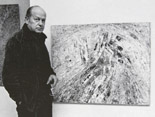
Jacques Germain was an internationally acclaimed member of the post-war Abstraction Lyrique group with Mathieu, Bryen, Riopelle, Vieira da Silva and Lanskoy, who were the European equivalent to the American Abstract Expressionists. As a young art student he had the privilege to work with Léger at the Académie Moderne (1931) and Kandinsky at the Bauhaus (from 1932 onwards). However his career was interrupted by the outbreak of war, during which he spent seven years as a prisoner in Germany.
It wasn’t until after WWII, which he remarkably survived, that Germain first exhibited his work, at the Salon des Surindépendants of 1947. After a short initial figurative period, he soon began to explore abstraction, which seemed natural to him, geometric at first, before developing the powerful resonant style of heightened gestural expression with which he achieved international success. His paintings, executed in this fluid manner, consist of an explosion of small rectangular surfaces, mostly in shades of white, lit by touches of vibrant colour. Germain’s contribution to the continuing re-interpretation of painting established him amongst the leading post-war painters, “The same French lyrical use of colour which found its great champion in Delaunay, has new exponents in Bazaine, Estève, Lombard and Germain” (M. Seuphor: A Dictionary of Abstract Painting, 1958).
Jacques Germain achieved international status in the 1950’s and featured in contemporary art exhibitions around the world until his recent death in 2001. In 1949 he started to exhibit at the Salon des Réalités Nouvelles, an annual Salon founded in 1946 dedicated solely to the display of abstract art. Germain also participated frequently in the famous yearly “École de Paris” shows at Galerie Charpentier alongside Atlan, Hartung, Soulages, Poliakoff, as well as in important group exhibitions both in France and abroad, most notably Le Mouvement dans l’art Contemporain (Musée de Lausanne, 1955), Exposition Internationale de l’Art Abstrait, to celebrate the publication of Michel Seuphor’s seminal book on abstract art in 1957, Ecole de Paris (Mannheim, 1959), and the Irish International Exhibition of Modern Art (Dublin, 1962). He also held regular solo shows at the galleries Maeght, Pierre, Michel Warren, Kriegel, André Schoeller, Jacques Massol and Dina Vierny.
The artist’s work is now represented in many museums of modern art including the Musée National d’Art Moderne - Centre Georges Pompidou (Paris), Musée d’Art Moderne (Paris, Ville), and the city museums of Lille, Bremen, Bergen, Lausanne, and Oslo.